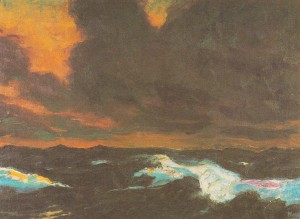 The Die Brucke group of Painters.
The Die Brucke group of Painters.
In a working class area of Dresden, Germany in 1905, a group of ex-architecture students got together to form a community of painters, rather in the way that the Guilds of The Middle Ages operated. Members of the group were Heckel, Kirchner, Pechstein, Schmidt-Rottluuf and for a short time Emil Nolde.
Emil Nolde 1867-1956, soon left the group to go travelling around Europe, he preferred solitude to work on his paintings, they show an integrated vision of the world, that celebrated a love of nature and all that was around him?
In 1930 he painted a series of paintings which he named The Sea. He worked on the island of Sylt, Germany. He wrote, ‘I had a wish to live and paint as alone as possible, only observing and in particular, I wanted to see the sea again, in all it’s wild greatness. His work portrays a savage wildness.
I love to paint the sea, aware of its constant ebb and flow, with huge skies that tower above, often filled with ever changing cloud patterns.
These painters have influenced future paintings in many ways, for example Expressionist painters in the 20th.century, such as Edvard Munch, who painted The Scream and The Sick Child. He wrote ‘there must be living beings painted, who breathe and feel and love and suffer’. His work displays these emotions. Violent distortion and execution of colour were used to express deep or violent emotions – not simply painting what the eye can see.
I wonder if these paintings absorb such emotions, neutralise them? Robert Ellis writes: ‘integration needs to be described in terms of psychological states, rather than just in terms of philosophical analysis of meaning’.
I would welcome your views please.

In a sense I think that all art potentially integrates meaning, because it gives us new symbols that we can relate to our experience. Whether or not it succeeds in bringing together for very long desires that would otherwise be separated, it at least it gives us more resources with which to do so. There might be a completely different discussion about what the works of these artists mean for our integration now, and whether they themselves were engaged in a process of integration.
Munch rather strikes me as someone who remained profoundly unintegrated – ‘The Scream’ seems like the work of someone on the way to a breakdown, which indeed he was, although he then recovered. However, as with Van Gogh, it can be argued that actually the art held off madness for a while. The correlation between artists and profoundly unintegrated states of mental breakdown may not be because the art causes the breakdown, but rather because the artists need the art to avoid breakdown.
There’s also a sense in which we can’t integrate extremes without fully acknowledging them first. I think it’s for that reason that I still appreciate the art of extremes. For example one of my favourite poems is Donne’s ‘Nocturne upon St Lucie’s Day’ – a poem of depression if ever there was one. If Iain McGilchrist is to be believed, depression is about the isolated, unintegrated left hemisphere, but melancholy, on the other hand, is something experienced through the right hemisphere. That would fit with some comments made about music in relation to Emilie’s blog post recently. I don’t find ‘The Scream’ depressing, even though it’s disturbing. Rather it puts us in touch with some apart of ourselves that needs recognition. That is perhaps a kind of extreme melancholy.
I’m not sure I feel I know enough about ‘Die Brucke’ to draw any conclusions about them as a whole, though. Could you explain more what you think they were bridging, Norma?